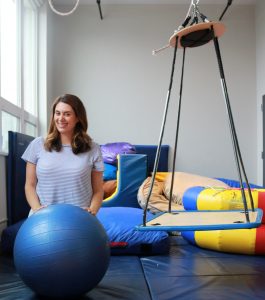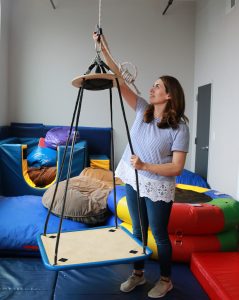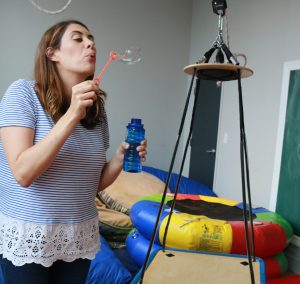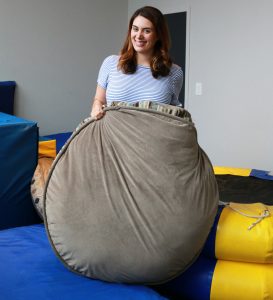What is a Sensory Diet?
A sensory diet is a set list of activities designed to provide the body the input it needs in order to participate in everyday tasks. The child who crashes too much might need to be squished between two pillows to get that deeper pressure to their joints and muscles. The child who won’t touch paint might exhibit less avoidance after receiving a hand massage to desensitize their touch receptors. The child who can’t sit still might be able to sit for all of circle time after jumping on a trampoline for 10 minutes.
An occupational therapist can help you determine the exact type of input your child’s body needs. However, the activities listed below can be trialed at home to serve as a starting point. I typically like to encourage one activity from the first list followed by an activity from the second. This allows a child to receive alerting movement input followed by calming deep pressure/heavy work input. This list of activities includes items that are typically found in most homes or playgrounds so they can be easily implemented at home.
Movement-Based Activities
- Running (e.g. around the block, playing tag, at a playground)
- Swinging- focus on back-and-forth swinging (as opposed to swinging in circles)
- Slide
- Log rolls
- Jumping on a trampoline
- Rollerskating/rollerblading
- Being pulled in a wagon
- Riding a bike
- Bouncing on a therapy ball
- Scooterboard
- Movement games- Red Light/Green Light, Simon Says
- Stretching (with or without Theraband)
- Somersaults, cartwheels, laying with head upside down
- Playing catch with a ball or balloon
- Jumping jacks


Deep Pressure/Heavy Work Activities
- Yoga
- Have child lay on stomach, roll therapy ball over body while providing continuous pressure
- Lotion massage (can be incorporated into bedtime routine)
- Pulling a wagon
- Carrying a laundry basket
- Wheelbarrow walks
- Animal walks (e.g. frog, crab)
- Getting rolled between two pillows (“Making a taco”)
- Laying on tummy on scooterboard and propelling with arms
- Climbing
- Crawling
- Blowing bubbles
- Chewing gum (or chewy candy)
- Use a weighted blanket
- Wall push-ups or “pushing over a wall” (hold for 10 seconds)
Ideally, a sensory diet is designed to be implemented throughout the day so children are provided input before dysregulation occurs. However, this can be difficult with so many demands placed, particularly at school. If you notice your child is having an especially hard time remaining focused or seated, focus on activities from the second list. If the child is appearing less alert and engaged, focus on activities from the first list. There is no perfect science behind a sensory diet but rather adjusting activities based on what a child’s body is telling us.
The increased push towards seated work and technology within our school systems means that many, if not most, children are not getting the input their body needs to function at their highest capacity. It can also make accomplishing tasks at home more difficult as children have been forced to sit all day and need to move! I encourage everyone to build some sensory activities into their homes routines in order to promote learning and engagement on every level!



Eyas Landing is a therapy clinic with a mission to provide evidence-based and family-centered therapy services for children, adolescents, and their families. The primary goal is to deliver relationship-based interventions within the most natural environments and to empower families to reach their full potential. To achieve this goal, our highly educated, compassionate staff dedicates time and expertise to create experiences that maximize therapeutic outcomes. The strength, determination, and perseverance of our clients are evident as they succeed in therapy, and ultimately in their daily lives.
Eyas Landing offers a wide range of comprehensive services including Speech Therapy, Occupational Therapy, Physical Therapy, ABA Therapy, Social Work, Family Therapy, and Neuropsych testing. Services are provided throughout the Chicagoland area via Telehealth, In-Home, and in our state of the art clinic.
Want to learn more or you have a specific question? Feel free to connect with us here!



